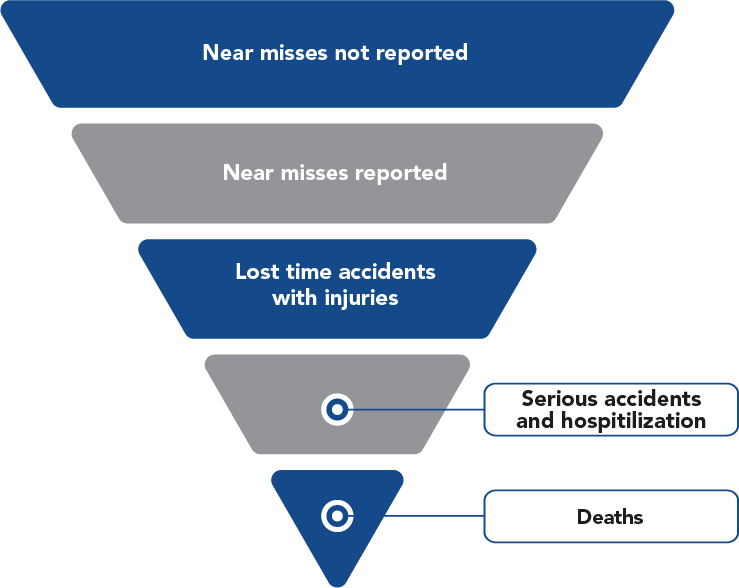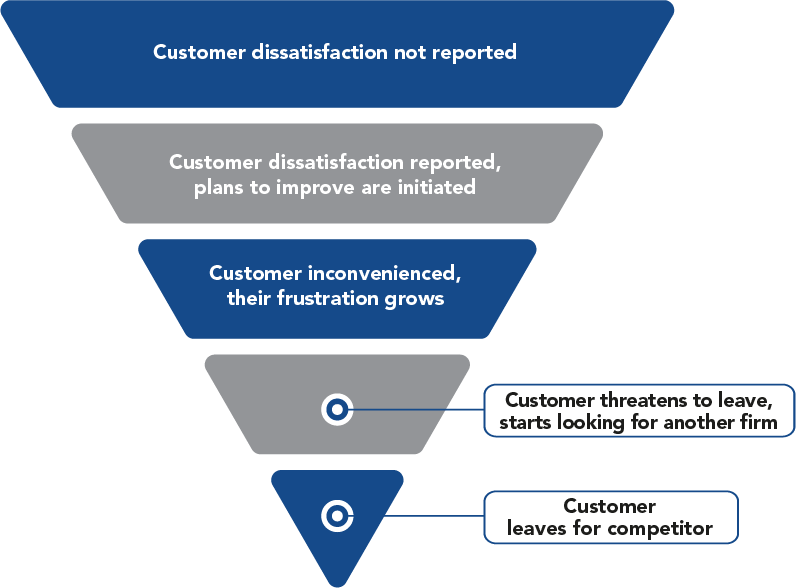by Bill Bertolet, Culture Consultant at levelUp Group, LLC
Safety is a vital pillar for success in various industries. As a culture consultant, I have experienced the importance of cultivating a strong safety culture that saves lives in hazardous work environments. This proven process has relevancy across industries when creating loyalty, achieving best-in-class sales results, and ensuring consistent quality.
In dangerous work environments, the Safety Funnel Effect serves as a valuable guide to prioritize near-miss reporting and proactively prevent accidents. In order to understand how we can apply these crucial culture lessons to other types of organizations, let’s first understand how the Safety Funnel Effect operates.

The Safety Funnel demonstrates the stages of safety in the workplace, with each level influencing the next. The wide opening at the top of the funnel represents the initial stage, and as you move downwards, the funnel narrows, signifying a decrease in the number of incidents but an increase in severity.
- Near Misses Not Reported: At the top of the funnel, we have the most significant area for improvement: near misses that go unreported. Failure to report near misses can be likened to neglecting a small crack in a dam—it might seem insignificant, but it has the potential to lead to disastrous consequences. Addressing this level is vital for preventing accidents further down the funnel. If workers are reluctant to report near misses, it speaks volumes about the reality of the safety culture that starts at the top. Examples exist of strict standards where employees are fired on the spot for any infractions of not reporting. The goal of this heavy-handed approach is to get the hourly workforce to be safer. However, it ends up having the opposite effect, fewer near misses are reported because the workforce protects others’ employment and doesn’t report the near misses. Preventing near misses is the ultimate goal of any culture of safety.
- Near Misses Reported: Reporting near misses allows for corrective action going forward to reduce or eliminate the chance of a repeat. A strong reporting culture allows organizations to identify potential hazards and implement preventive measures before accidents occur. It is the first proactive step in building a resilient culture of safety.
- Lost Time Accidents with Injuries: Moving further down the funnel, we encounter accidents resulting in injuries and requiring time off work. These incidents are like breaches in the dam, allowing water to seep through. While reporting near misses is critical, preventing accidents at this level is even more crucial for reducing human suffering and operational disruptions.
- Serious Accidents with Hospitalizations: At this level of the funnel, accidents have escalated to the point where employees require hospitalization. Staying with our dam analogy, these incidents are like significant cracks in the dam, demanding immediate action. Quickly identifying and addressing the root causes of serious accidents is essential to protect both employees and the organization’s reputation.
- Deaths: At the bottom of the funnel is the most tragic and catastrophic outcome—fatalities. A death in the workplace is like a complete dam failure, causing widespread devastation and irreversible consequences. Preventing fatalities is obviously the critical goal of every safety culture.
Let’s take a closer look at the top of the funnel with near misses not reported, and why the big problems start there. Non-reported near misses can be attributed to several characteristics of the company’s culture that hinder employees from coming forward and sharing important information. Understanding these underlying factors is essential for creating an environment where near-miss reporting is encouraged and valued.
- Fear of Repercussions: Employees may fear punishment, blame, reprisals, or someone getting fired for reporting near misses. In some company cultures, reporting incidents is viewed as a sign of incompetence or negligence, leading employees to avoid reporting to protect their reputation or job security.
- Lack of Trust: A culture lacking trust and psychological safety discourages open communication. If employees don’t trust that their near-miss reports will be taken seriously and acted upon, they are unlikely to come forward with potentially valuable information.
- Time Constraints: Employees may believe that reporting near misses is time-consuming and could impede their daily tasks or responsibilities. If reporting processes are cumbersome or not integrated into daily operations, employees may choose to overlook them.
- Perception of Futility: When employees perceive that near-miss reporting does not lead to meaningful change or improvement, they may question the value of reporting incidents. If previous near-miss reports have gone unaddressed, employees may feel disheartened and reluctant to report future incidents.
- Lack of Communication and Training: Inadequate communication and training on the importance and process of near-miss reporting can lead to misunderstandings about its value. If employees are not aware of how near-miss reports contribute to safety improvements, they may not prioritize reporting incidents.
Here are some ways leaders can be proactive in addressing these root causes:
- Emphasize the value of near-miss reporting.
- Establish a learning-oriented culture.
- Provide the necessary support and resources to empower employees to come forward.
At this point you may be saying to yourself, “Bill, this is great information, but I don’t work in a hazardous environment, so what does this mean for me?” Great question! Let’s talk about how the principles of safety can drive success in other companies and departments.
Driving Customer Loyalty in Customer-Service Cultures
While employees in dangerous work environments prioritize safety for the well-being of everyone involved, the equivalent in customer service-oriented companies is to place customer satisfaction at the forefront. A strong focus on delivering excellent customer service mirrors the significance of safety in hazardous workplaces.

Non-reported customer dissatisfaction can be attributed to several factors. Here’s an example from an office product company I worked with that provides field engineers to fix equipment at the customer site. One of the senior engineers, noted for his years of technical expertise, often left a job without reporting to the facility manager what work had been done. While the equipment in question, a broken copy machine had been fully repaired, the case wasn’t closed out properly, leaving the customer with questions. The billing department heard this complaint from the customer, but didn’t share it with management, not wanting the field engineer to be reprimanded. Result: the field engineer’s behavior continued, and poor customer service continued. An opportunity to forge customer loyalty was lost.
Understanding these types of underlying factors is essential for creating a culture where reporting customer dissatisfaction is encouraged and valued.
Encourage employees in customer-service based companies to listen and respond promptly to customer feedback. Addressing minor customer concerns prevents larger issues, fosters loyalty, and leads to delighted and loyal customers.
Accomplishing Best-in-Class Sales Results in Sales-Excellence Cultures
In sales-driven organizations, the pursuit of excellence is paramount to achieving top results. Sales teams must identify potential risks and challenges in their strategies early on, just as near-miss reporting identifies potential hazards before accidents occur. This attention improves closing ratios and drives growth.

Attaining Zero Defects and Consistent Quality in Total Quality Management (TQM) Cultures
In a total quality management culture, the focus is on maintaining excellence and consistency. Encourage employees in TQM cultures to report even minor quality deviations, similar to near-miss reporting in safety cultures. Addressing these issues promptly ensures zero defects and consistent quality throughout the organization.
I partnered with an automobile assembly facility and prior to TQM, management was solely focused on daily production. Keeping the line moving was most important. When TQM was introduced, this plant was bold and allowed workers to pause the assembly line if they discovered a flaw. As you can imagine, this was a costly move. Yet the company had the foresight to prevent future defects by making improvements on the spot. Just like near misses being reported, rewarding assembly line employees for doing the right thing creates the path to zero defects.

Final Thoughts
The idea of the Safety Funnel is universal and transcends industry boundaries and organizational cultures. Drawing from the Safety Funnel Effect and the lessons learned in improving safety in hazardous work environments, we can apply these principles to drive success in customer service cultures, sales excellence cultures, and total quality management cultures.
A proactive and vigilant approach to reporting issues when they are first identified leads to success in customer satisfaction, sales results, and quality management. Just as a robust safety culture protects employees in hazardous workplaces, this approach safeguards the health and well-being of businesses in the long run.
Remember, cultivating excellence in various industries is a journey, not a destination. By continuously learning from one another and implementing the best practices from dangerous work environments, we can build thriving, customer-centric, sales-driven, and quality-focused organizations that stand the test of time.
To learn more about your organization’s culture, download our free Culture Readiness Tool.

